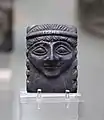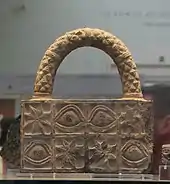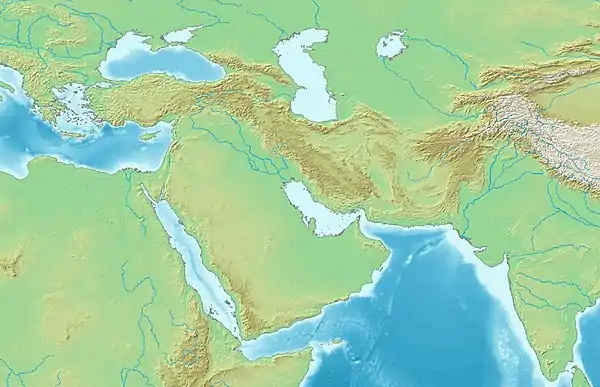| A'annepada 𒀀𒀭𒉌𒅆𒊒𒁕 | |
|---|---|
| King of Kish, King of Ur | |
 Gold dagger from tomb PG 580, thought to belong to A'anepada. | |
| Reign | fl. c. 2600 BCE |
| Predecessor | Mesannepada |
| Successor | Meskiagnun (brother) |
| House | First Dynasty of Ur |
A'annepada (Sumerian: 𒀀𒀭𒉌𒅆𒊒𒁕, romanized: A'an-na-pad-da) was a king of the First Dynasty of Ur, c. 2600 BCE.[1][2] He was a son of Mesannepada.[1][3] It is thought that his tomb may be tomb PG 580 in the Royal Cemetery at Ur.[1]
Votive tablets
Several tablets are known that bear his name, in particular dedicated to Ninhursag, and proclaiming Mesannepada as his father:[4]
A'annepada tablet inscription. British Museum.[5]𒀭𒊩𒌆𒄯𒊕 / 𒀀𒀭𒉌𒅆𒊒𒁕 / 𒈗𒌶𒆠 / 𒌉𒈩𒀭𒉌𒅆𒊒𒁕 / 𒈗𒌶𒆠 /𒀭𒊩𒌆𒉺𒂅𒊏 / 𒂍 𒈬𒈾𒆕
Dnin-hur-sag / a-an-ne2-pa3-da / lugal uri5{ki} / dumu mes-an-ne2-pa3-da / lugal uri5{ki} /Dnin-hur-sag-ra / e2 mu-na-du3
"For Nin-hursag: A'annepada, king of Ur, son of Mesannepada, king of Ur, built the temple for Ninhursag."
Foundation cone
A foundation cone in a copper alloy was found in Ur, bearing the name of "King A'annepada" in a dedication for Inanna, now in the British Museum (BM 90951).[7][8][9][10]
The cone was discovered by John George Taylor in 1854 during his excavations in Ur.[9] It has a length of 34.3 centimetres, and a diameter of 3.7 centimetres, and weighs 1.7 kilograms.[9][8] According to the British Museum, it was found together with two other objects, a carved stone with handle and a lapis lazuli portrait, which together probably formed a foundation deposit.[11]
The actual content of the inscription had been overlooked, until it was published by J.C. Gadd in 1928.[8]
 Lapis lazuli female portrait found with the cone in the same foundation deposit.[12]
Lapis lazuli female portrait found with the cone in the same foundation deposit.[12] Carved stone with handle, from the same foundation deposit. It is probably Elamite in origin.[13] The motif was reused on the white platform in The Babylonian Marriage Market.[14]
Carved stone with handle, from the same foundation deposit. It is probably Elamite in origin.[13] The motif was reused on the white platform in The Babylonian Marriage Market.[14] A'annepada foundation cone in 1915, before decipherement
A'annepada foundation cone in 1915, before decipherement
Artifacts from tomb PG 580 at Ur
It has been suggested that the tomb of A'annepada may be tomb PG 580 in the Royal Cemetery at Ur.[1]
.jpg.webp) Dagger
Dagger Copper alloy axe
Copper alloy axe Copper Alloy Chisel, Harpoons, Lance and Spear Heads.
Copper Alloy Chisel, Harpoons, Lance and Spear Heads. Jewellery PG 580
Jewellery PG 580 Jewellery PG 580
Jewellery PG 580
References
- 1 2 3 4 Reade, Julian (2003). Art of the First Cities: The Third Millennium B.C. from the Mediterranean to the Indus. Metropolitan Museum of Art. pp. 94–96. ISBN 978-1-58839-043-1.
- ↑ Thomas, Ariane; Potts, Timothy (2020). Mesopotamia: Civilization Begins. Getty Publications. p. 13. ISBN 978-1-60606-649-2.
- ↑ Pr, Univ Of Pennsylvania; Anthropology, University of Pennsylvania Museum of Archaeology and; Hansen, Donald P.; Pittman, Holly (1998). Treasures from the Royal Tombs of Ur. UPenn Museum of Archaeology. p. 3. ISBN 978-0-924171-54-3.
- ↑ "CDLI-Found Texts". cdli.ucla.edu.
- 1 2 "British Museum, tablet".
- ↑ "CDLI-Archival View". cdli.ucla.edu.
- 1 2 "CDLI-Archival View". cdli.ucla.edu.
- 1 2 3 4 Gadd, C. J. (1928). "Another A-Anni-Padda Inscription". Journal of the Royal Asiatic Society of Great Britain and Ireland (3): 626–628. ISSN 0035-869X. JSTOR 25221375.
- 1 2 3 4 "Dedicatory cone". British Museum.
- ↑ W. King., Leonard (1915). A History of Babylonia. pp. 153–154.
- ↑ Museum notice
- ↑ Museum notice
- ↑ Museum notice
- ↑ Collections Online British Museum.

.jpg.webp)

